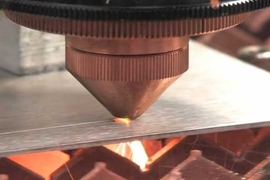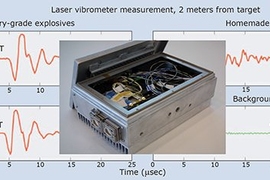Six technologies developed by MIT Lincoln Laboratory were named recipients of 2014 R&D 100 Awards, presented annually by R&D Magazine to recognize the prior year's 100 most technologically significant innovations. Each year, R&D Magazine — an international publication for research scientists, engineers, and technical staff — chooses the winners from among hundreds of nominations submitted by industry, government labs, and university research centers from across the globe.
The 2014 R&D 100 Award recipients from Lincoln Laboratory are:
- Airborne Sense-and-Avoid Radar Panel — a novel stepped-notch antenna array that supports aircraft and weather detection and tracking modes in a single multifunction aperture
- Curled Microelectromechanical Switch — a curled-electrode switch that eliminates the sticking and contamination issues inherent in traditional electromechanical switches
- Haystack Ultrawideband Satellite Imaging Radar — a ground-based, dual X- and W-band sensor that can produce very high-resolution images of objects orbiting Earth
- Localizing Ground-Penetrating Radar — a robust sensor that provides real-time vehicular global-position estimates based on prior mapping of subsurface features
- Lunar Laser Communication System — an optical system that achieves very high uplink and downlink data rates between an Earth terminal and a distant satellite
- Wide-Area Chemical Sensor — a highly precise, self-referencing spectrometer that measures the concentrations of specified target gases within the atmosphere
Winners of R&D 100 Awards are selected by R&D Magazine editors, who receive guidance from an independent panel of experts. Awards are typically presented in around 20 technology categories. During the 52 years of the award's presentation, winners have included sophisticated testing equipment, innovative new materials, biomedical products, and consumer items. Such familiar inventions as the NicoDerm anti-smoking patch and the high-definition television (HDTV) were past R&D 100 Award recipients.
Including the six 2014 winners, Lincoln Laboratory has received 22 R&D 100 Awards since 2010. In addition, the Lincoln Laboratory received two earlier R&D 100 Awards: one in 1998 jointly with Cyra Technologies and the Los Alamos National Laboratory, and the other in 1995.
The 52nd annual R&D 100 banquet and awards presentation will honor the 2014 winners on Nov. 7 at the Bellagio Hotel in Las Vegas. The day-long event will include an exhibition of winning technologies, a formal cocktail reception, and a black-tie banquet and awards presentation.
For more detailed descriptions of the winning technologies, please see the full story at http://www.ll.mit.edu/news/2014_RD100awards.html.









